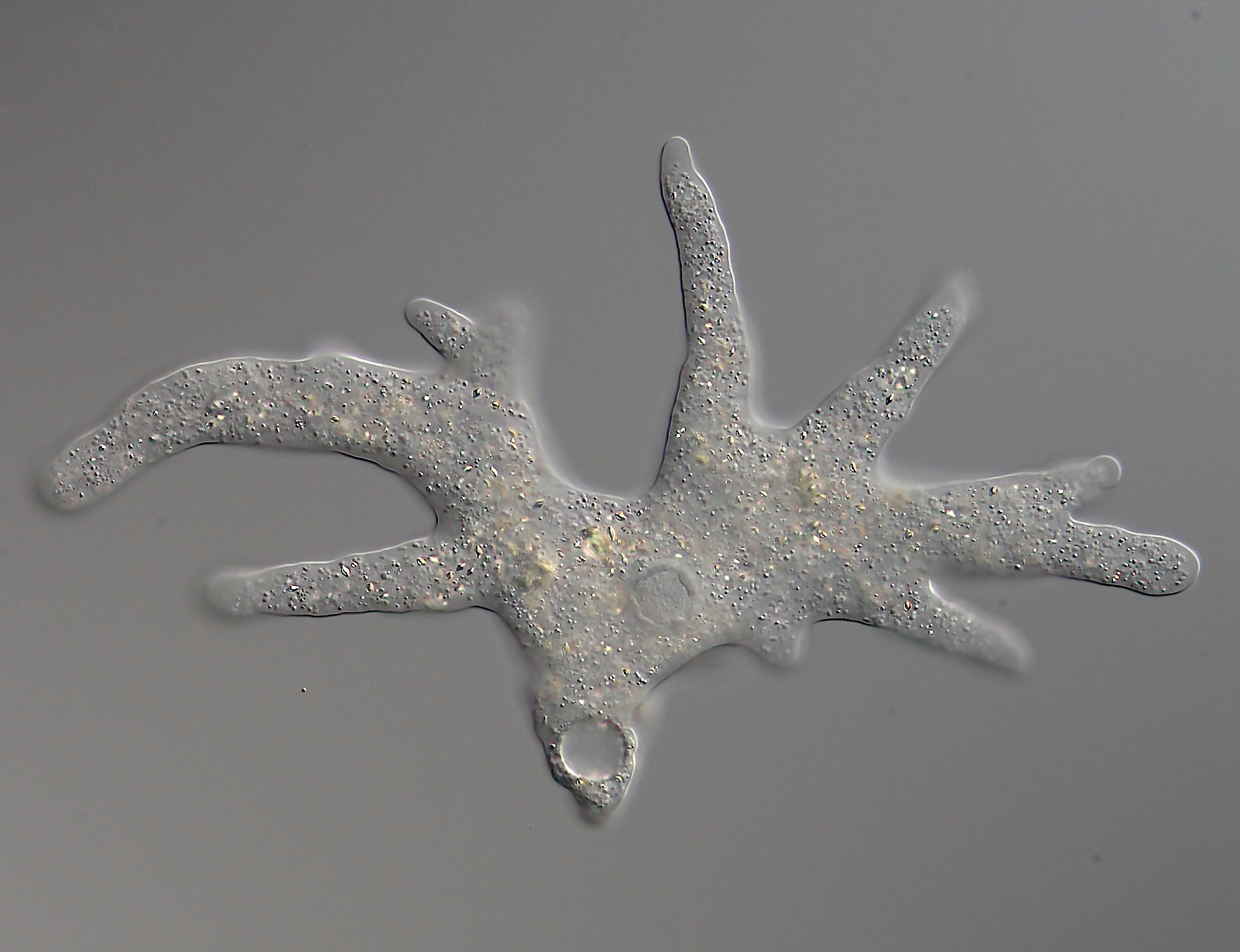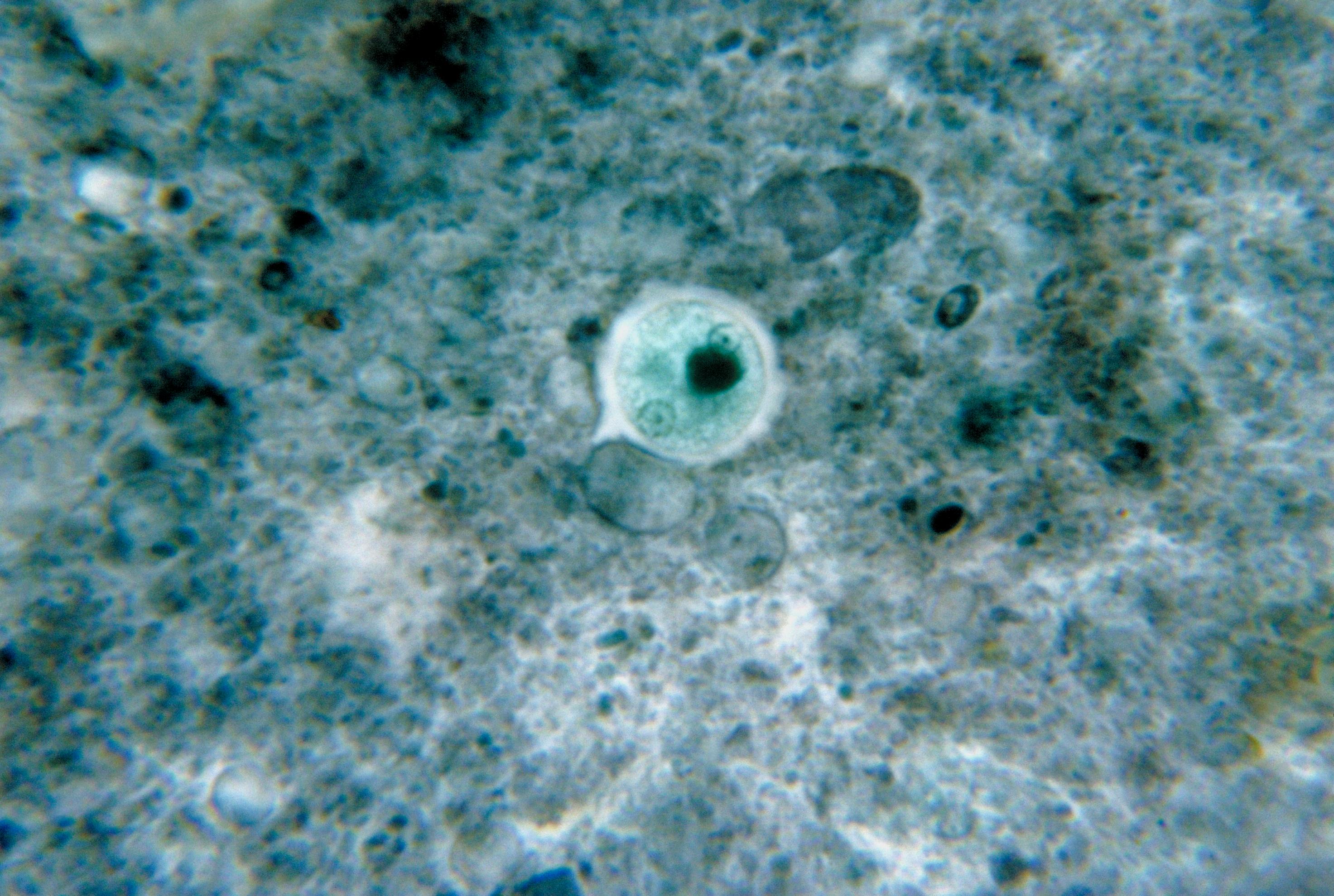|
Protacanthamoeba
''Protacanthamoeba'' is a genus of free-living naked amoebae of the family Acanthamoebidae described in 1981. It has been found in associations with mycobacteria in drinking water networks, along with other Acanthamoebidae genera, likely allowing the replication of both environmental and pathogenic mycobacteria. Morphology Members of ''Protacanthamoeba'' are characterized by having slender, flexible and sometimes furcate subpseudopodia originated from a broad, hyaline lobose pseudopodium, as well as having centrospheres in its interior, including a plaque-shaped centriole-like body. Their cysts lack preformed pores or opercula. Taxonomy ''Protacanthamoeba'' contains 3 species: * '' Protacanthamoeba bohemica'' * '' Protacanthamoeba caledonica'' * '' Protacanthamoeba invadens'' (previously ''Acanthamoeba ''Acanthamoeba'' is a genus of amoeboid, amoebae that are commonly recovered from soil, fresh water, and other habitat (ecology), habitats. The genus ''Acanthamoeba'' has ... [...More Info...] [...Related Items...] OR: [Wikipedia] [Google] [Baidu] |
Protacanthamoeba Bohemica
''Protacanthamoeba bohemica''Dykova, I., Veverkova-Fialova, M., Fiala, I. & Dvorakova, H. (2005). ''Protacanthamoeba bohemica'' sp. n., isolated from the liver of tench '' Tinca tinca'' (Linnaeus, 1758). Acta Protozool 44, 369–376. is a species of Acanthamoebidae Acanthamoebidae is a family of single-celled eukaryotes within the group Amoebozoa. It gets its name from '' Acanthamoeba'', its best-known member. However, it also includes other species, such as '' Comandonia operculata'' and '' Protacanthamoe .... See also * '' Protoacanthamoeba'' References Discosea Amoebozoa species {{Amoebozoa-stub ... [...More Info...] [...Related Items...] OR: [Wikipedia] [Google] [Baidu] |
Acanthamoebidae
Acanthamoebidae is a family of single-celled eukaryotes within the group Amoebozoa. It gets its name from '' Acanthamoeba'', its best-known member. However, it also includes other species, such as '' Comandonia operculata'' and '' Protacanthamoeba bohemica''. Many kinds of Acanthamoebidae are highly prevalent in the soil and water of a variety of environments. They are similar to Hartmannella, but have differently structured pseudopodia, in regard to the actin microfilaments that comprise them. Its most prominent member, ''Acanthamoeba'', can be potentially pathogenic to humans and animals. It has been described as having a common origin with the Entamoebidae and Dictyosteliida. Structure Members of Acanthamoebidae have a specific form of pseudopodia, dubbed acanthopodia. These acanthopodia are continuously formed and reabsorbed, protrude from every area of the cell's surface, and are usually, short and fine. An exception would be ''A. astronyxis'' and ''A. comandoni'', in ... [...More Info...] [...Related Items...] OR: [Wikipedia] [Google] [Baidu] |
Mycobacteria
''Mycobacterium'' is a genus of over 190 species in the phylum Actinomycetota, assigned its own family, Mycobacteriaceae. This genus includes pathogens known to cause serious diseases in mammals, including tuberculosis ('' M. tuberculosis'') and leprosy ('' M. leprae'') in humans. The Greek prefix ''myco-'' means 'fungus', alluding to this genus' mold-like colony surfaces. Since this genus has cell walls with a waxy lipid-rich outer layer containing high concentrations of mycolic acid, acid-fast staining is used to emphasize their resistance to acids, compared to other cell types. Mycobacterial species are generally aerobic, non-motile, and capable of growing with minimal nutrition. The genus is divided based on each species' pigment production and growth rate. While most ''Mycobacterium'' species are non-pathogenic, the genus' characteristic complex cell wall contributes to evasion from host defenses. Microbiology Morphology Mycobacteria are aerobic with 0.2-0.6 ... [...More Info...] [...Related Items...] OR: [Wikipedia] [Google] [Baidu] |
Lobosa
Lobosa is a taxonomic group of amoebae in the phylum Amoebozoa. Most lobosans possess broad, bluntly rounded pseudopods, although one genus in the group, the recently discovered ''Sapocribrum,'' has slender and threadlike (filose) pseudopodia. In current classification schemes, Lobosa is a subphylum, composed mainly of amoebae that have lobose pseudopods but lack cilia or flagella. Characteristics The group was originally proposed in 1861 by William B. Carpenter, who created it as a taxonomic order containing the single family Amoebina. Carpenter's Lobosa consisted of amoeboid organisms whose endoplasm (endosarc) flows into lobe-like "pseudopodian prolongations." This type of pseudopod, which was understood to be typical of the genus Amoeba "and its allies," differed from the filose (thread-like) or reticulose (netlike) pseudopods of the Foraminifera. The name Lobosa was chosen for these amoebae "as expressing the lobe-like character of their pseudopodial extensions". As cur ... [...More Info...] [...Related Items...] OR: [Wikipedia] [Google] [Baidu] |
Pseudopodium
A pseudopod or pseudopodium (: pseudopods or pseudopodia) is a temporary arm-like projection of a eukaryotic cell membrane that is emerged in the direction of movement. Filled with cytoplasm, pseudopodia primarily consist of actin filaments and may also contain microtubules and intermediate filaments. Pseudopods are used for motility and ingestion. They are often found in amoebas. Different types of pseudopodia can be classified by their distinct appearances. Lamellipodia are broad and thin. Filopodia are slender, thread-like, and are supported largely by microfilaments. Lobopodia are bulbous and amoebic. Reticulopodia are complex structures bearing individual pseudopodia which form irregular nets. Axopodia are the phagocytosis type with long, thin pseudopods supported by complex microtubule arrays enveloped with cytoplasm; they respond rapidly to physical contact. Generally, several pseudopodia arise from the surface of the body, (''polypodial'', for example, ''Amoeba proteus ... [...More Info...] [...Related Items...] OR: [Wikipedia] [Google] [Baidu] |
Centriole
In cell biology a centriole is a cylindrical organelle composed mainly of a protein called tubulin. Centrioles are found in most eukaryotic cells, but are not present in conifers ( Pinophyta), flowering plants ( angiosperms) and most fungi, and are only present in the male gametes of charophytes, bryophytes, seedless vascular plants, cycads, and ''Ginkgo''. A bound pair of centrioles, surrounded by a highly ordered mass of dense material, called the pericentriolar material (PCM), makes up a structure called a centrosome. Centrioles are typically made up of nine sets of short microtubule triplets, arranged in a cylinder. Deviations from this structure include crabs and ''Drosophila melanogaster'' embryos, with nine doublets, and '' Caenorhabditis elegans'' sperm cells and early embryos, with nine singlets. Additional proteins include centrin, cenexin and tektin. The main function of centrioles is to produce cilia during interphase and the aster and the spindle durin ... [...More Info...] [...Related Items...] OR: [Wikipedia] [Google] [Baidu] |
Microbial Cyst
A microbial cyst is a resting or dormant stage of a microorganism, that can be thought of as a state of suspended animation in which the metabolic processes of the cell are slowed and the cell ceases all activities like feeding and locomotion. Many groups of single-celled, microscopic organisms, or microbes, possess the ability to enter this dormant state. Encystment, the process of cyst formation, can function as a method for dispersal and as a way for an organism to survive in unfavorable environmental conditions. These two functions can be combined when a microbe needs to be able to survive harsh conditions between habitable environments (such as between hosts) in order to disperse. Cysts can also be sites for nuclear reorganization and cell division, and in parasitic species they are often the infectious stage between hosts. When the encysted microbe reaches an environment favorable to its growth and survival, the cyst wall breaks down by a process known as excystation. E ... [...More Info...] [...Related Items...] OR: [Wikipedia] [Google] [Baidu] |
Tinca Tinca
The tench or doctor fish (''Tinca tinca'') is a fresh- and brackish-water fish of the order Cypriniformes found throughout Eurasia from Western Europe including Britain and Ireland east into Asia as far as the Ob and Yenisei Rivers. It is also found in Lake Baikal. It normally inhabits slow-moving freshwater habitats, particularly lakes and lowland rivers.B. Whitton (1982). ''Rivers, Lakes and Marshes'' p 163. Hodder & Staughton, London. Taxonomy The tench was first formally described in as ''Cyprinus tinca'' by Carl Linnaeus in 1758 in the 10th edition of Systema Naturae with its type locality given as "European lakes". In 1764 François Alexandre Pierre de Garsault proposed the new monospecific genus ''Tinca'', with ''Cyprinus tinca'' as the type species by absolute tautonymy. The 5th edition of ''Fishes of the World'' classified ''Tinca'' in the subfamily Tincinae, alongside the genus ''Tanichthys'', while other authorities classified both these genera in the subfamily ... [...More Info...] [...Related Items...] OR: [Wikipedia] [Google] [Baidu] |
Acanthamoeba
''Acanthamoeba'' is a genus of amoeboid, amoebae that are commonly recovered from soil, fresh water, and other habitat (ecology), habitats. The genus ''Acanthamoeba'' has two stages in its life cycle, the metabolically active trophozoite stage and a dormant, stress-resistant Microbial cyst, cyst stage. In nature, ''Acanthamoeba'' species are generally free-living bacterivores. However, they are also opportunistic pathogens able to cause serious and potentially fatal infections in humans and other animals. Distribution ''Acanthamoeba'' spp. are among the most prevalent protozoa found in the environment. They are distributed worldwide, and have been isolated from soil, air, sewage, seawater, chlorinated swimming pools, domestic tap water, bottled water, dental treatment units, hospitals, air-conditioning units, and contact lens cases. Additionally, they have been isolated from human skin, nasal cavities, throats, and intestines, as well as plants and other mammals. Role in disea ... [...More Info...] [...Related Items...] OR: [Wikipedia] [Google] [Baidu] |
Discosea
Discosea is a class of Amoebozoa, consisting of naked amoebae with a flattened, discoid body shape. Members of the group do not produce tubular or subcylindrical pseudopodia, like amoebae of the class Tubulinea. When a discosean is in motion, a transparent layer called ''hyaloplasm'' forms at the leading edge of the cell (see lamellipodium). In some discoseans, short "subpseudopodia" may be extended from this hyaloplasm, but the granular contents of the cell do not flow into these, as in true pseudopodia. Discosean amoebae lack hard shells, but some, like ''Cochliopodium'' and '' Korotnevella'' secrete intricate organic scales which may cover the upper (dorsal) surface of the cell. No species have flagella or flagellated stages of life. The composition of Discosea is similar to that of the class Flabellinea, proposed by Alexey Smirnov and his collaborators in 2005. However, Discosea is a more comprehensive taxon, including several groups not included in Flabellinea. In 2011, ... [...More Info...] [...Related Items...] OR: [Wikipedia] [Google] [Baidu] |





